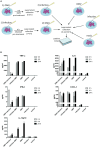Protective potential of outer membrane vesicles derived from a virulent strain of Francisella tularensis
- PMID: 38533334
- PMCID: PMC10963506
- DOI: 10.3389/fmicb.2024.1355872
Protective potential of outer membrane vesicles derived from a virulent strain of Francisella tularensis
Abstract
Francisella tularensis secretes tubular outer membrane vesicles (OMVs) that contain a number of immunoreactive proteins as well as virulence factors. We have reported previously that isolated Francisella OMVs enter macrophages, cumulate inside, and induce a strong pro-inflammatory response. In the current article, we present that OMVs treatment of macrophages also enhances phagocytosis of the bacteria and suppresses their intracellular replication. On the other hand, the subsequent infection with Francisella is able to revert to some extent the strong pro-inflammatory effect induced by OMVs in macrophages. Being derived from the bacterial surface, isolated OMVs may be considered a "non-viable mixture of Francisella antigens" and as such, they present a promising protective material. Immunization of mice with OMVs isolated from a virulent F. tularensis subsp. holarctica strain FSC200 prolonged the survival time but did not fully protect against the infection with a lethal dose of the parent strain. However, the sera of the immunized animals revealed unambiguous cytokine and antibody responses and proved to recognize a set of well-known Francisella immunoreactive proteins. For these reasons, Francisella OMVs present an interesting material for future protective studies.
Keywords: FSC200; Francisella tularensis; host-pathogen interaction; outer membrane vesicles; vaccination.
Copyright © 2024 Pavkova, Bavlovic, Kubelkova, Stulik and Klimentova.
Conflict of interest statement
The authors declare that the research was conducted in the absence of any commercial or financial relationships that could be construed as a potential conflict of interest.
Figures






Similar articles
-
Francisella tularensis Outer Membrane Vesicles Participate in the Early Phase of Interaction With Macrophages.Front Microbiol. 2021 Oct 15;12:748706. doi: 10.3389/fmicb.2021.748706. eCollection 2021. Front Microbiol. 2021. PMID: 34721352 Free PMC article.
-
Intact O-antigen is critical structure for the exceptional tubular shape of outer membrane vesicles in Francisella tularensis.Microbiol Res. 2023 Apr;269:127300. doi: 10.1016/j.micres.2023.127300. Epub 2023 Jan 12. Microbiol Res. 2023. PMID: 36641863
-
Cross-Species Proteomic Comparison of Outer Membrane Vesicles and Membranes of Francisella tularensis subsp. tularensis versus subsp. holarctica.J Proteome Res. 2021 Mar 5;20(3):1716-1732. doi: 10.1021/acs.jproteome.0c00917. Epub 2021 Feb 5. J Proteome Res. 2021. PMID: 33543941
-
Live Attenuated Tularemia Vaccines for Protection Against Respiratory Challenge With Virulent F. tularensis subsp. tularensis.Front Cell Infect Microbiol. 2018 May 15;8:154. doi: 10.3389/fcimb.2018.00154. eCollection 2018. Front Cell Infect Microbiol. 2018. PMID: 29868510 Free PMC article. Review.
-
Francisella tularensis: taxonomy, genetics, and Immunopathogenesis of a potential agent of biowarfare.Annu Rev Microbiol. 2006;60:167-85. doi: 10.1146/annurev.micro.60.080805.142126. Annu Rev Microbiol. 2006. PMID: 16704343 Free PMC article. Review.
Cited by
-
Outer membrane vesicles in gram-negative bacteria and its correlation with pathogenesis.Front Immunol. 2025 Apr 1;16:1541636. doi: 10.3389/fimmu.2025.1541636. eCollection 2025. Front Immunol. 2025. PMID: 40236702 Free PMC article. Review.
References
LinkOut - more resources
Full Text Sources

